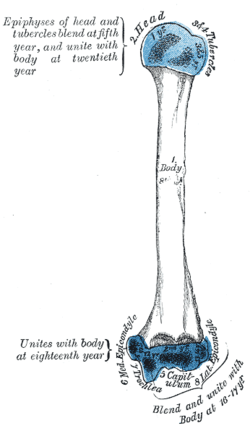Medial epicondyle of the humerus
| Medial epicondyle of the humerus | |
|---|---|
|
Left elbow-joint, showing anterior and ulnar collateral ligaments. (Medial epicondyle labeled at center top.) | |
 Plan of ossification of the humerus. (Medial epicondyle labeled at lower left.) | |
| Details | |
| Identifiers | |
| Latin | Epicondylus medialis humeri |
| TA | A02.4.04.027 |
| FMA | 23441 |
The medial epicondyle of the humerus in humans is larger and more prominent than the lateral epicondyle and is directed slightly more posteriorly in the anatomical position. In birds, where the arm is somewhat rotated compared to other tetrapods, it is called ventral epicondyle of the humerus. In comparative anatomy, the more neutral term entepicondyle is used.
It gives attachment to the ulnar collateral ligament of elbow joint, to the Pronator teres, and to a common tendon of origin (the common flexor tendon) of some of the Flexor muscles of the forearm: Flexor carpi radialis, flexor carpi ulnaris, flexor digitorum superficialis. As well as palmaris longus.
The ulnar nerve runs in a groove on the back of this epicondyle. The medial epicondyle protects the ulnar nerve. The ulnar nerve is vulnerable because it passes close to the surface along the back of the bone. Striking the medial epicondyle causes a tingling sensation in the ulnar nerve. This response is known as striking the “funny bone”.[1] The name funny bone could be from a play on the words humorous and humerus, the bone on which the medial epicondyle is located. The medial epicondyle is located on the distal end of the humerus. Additionally, the medial epicondyle is inferior to the medial supracondylar ridge. It is also proximal to the olecranon fossa.
Additional images
 Left humerus. Anterior view.
Left humerus. Anterior view. Front of the left forearm. Superficial muscles.
Front of the left forearm. Superficial muscles. Posterior surface of the forearm. Deep muscles.
Posterior surface of the forearm. Deep muscles.- Elbow joint. Deep dissection. Posterior view.
- Elbow joint. Deep dissection. Posterior view.
- Elbow joint. Deep dissection. Posterior view.
References
This article incorporates text in the public domain from the 20th edition of Gray's Anatomy (1918)
External links
- Anatomy figure: 07:02-02 at Human Anatomy Online, SUNY Downstate Medical Center
- aplab - BioWeb at University of Wisconsin System
- radiographsul at The Anatomy Lesson by Wesley Norman (Georgetown University) (xrayelbow)